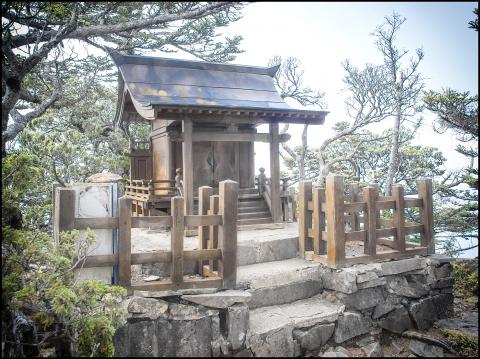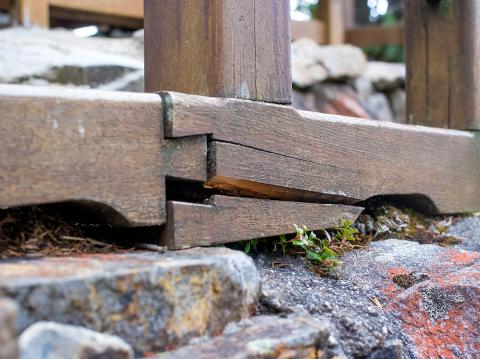When the Japanese became colonial rulers of Taiwan in 1895, they inherited a population of Chinese immigrants and Aboriginal peoples. The first years of Japanese colonial rule included suppression of uprisings. In 1919 the Japanese governor implemented the Doka movement of assimilation; with the outbreak of Second Sino-Japanese War in 1937 came a new policy: the Kominka movement. Kominka was regarded as necessary for the Japanese war effort, to make the Taiwanese colonial subjects identify more strongly with Japan, and not China.
One element of the Kominka movement was to have Taiwanese convert to Shinto, Japan’s indigenous religion of worshipping spirits manifest in natural forms such as trees, rivers and people. Shinto shrines were set up around the country, including some of the high altitude areas such as Jade Mountain and Snow Mountain.
If you visit Jade Mountain West Peak today you will see a Japanese shrine there. This is not the original structure: After Japan ceded control of Taiwan at the end of World War II, many of the shinto shrines around the island were destroyed. The West Peak shrine is a reconstruction commissioned by the Jade Mountain National Park, made entirely of wood and reflecting the Japanese style of the original, repurposed as a shrine to the local spirits.

Photo: Paul Cooper, Taipei Times
照片:台北時報記者古德謙攝
On the day I was there, Taiwanese hikers made a point of praying at the shrine. They thanked the spirits for the good weather, and wished for safe passage down the mountain.
The shrine has a simplistic elegance. Unfortunately, its exposure to the elements has taken its toll. The wood itself is in remarkable condition; the stone base less so. Cracked and broken through temperature alternations, it has become misshapen, warping the wooden railings. The rear right corner post had fallen to the forest floor.
(Paul Cooper, Taipei Times)
.jpg)
Photos: Paul Cooper, Taipei Times
照片:台北時報記者古德謙攝
日本人在一八九五年成為台灣的殖民統治者,當時他們所接管的台灣人民主要由中國移民和原住民組成。在殖民統治的最初幾年,日本政府著重於鎮壓抗日運動;及至一九一九年,日本總督改實施同化政策;隨著一九三七年第二次中日戰爭爆發,日本政府遂推行一項新政策──「皇民化運動」,目的是讓殖民統治下的台灣臣民更加強烈認同日本,而非中國。對於日本的戰事而言,皇民化運動可說是勢在必行。
皇民化運動的元素之一,是要求台灣人改信神道教,也就是日本原生的泛靈宗教,崇拜在自然界形態中──包括樹木、河川,以及人類──顯現其靈的世間萬物。神道教的神社遂開始設立於台灣各地,就連玉山和雪山等高海拔地區也不例外。
今天,在拜訪玉山西峰的路上,你還能看見一座日式神社,只是該建物現狀已非最初的結構:日本在第二次世界大戰尾聲放棄台灣主權後,台灣本島各地許多神道教神社都被拆毀。今日玉山西峰的這座神社其實是玉山國家公園委託重建,建築整體全以木造完成,反映原建物的日式風格,並且重新改作為山神祠。

Photos: Paul Cooper, Taipei Times
照片:台北時報記者古德謙攝
在我造訪西山神祠當天,台灣的登山客們特地向神祠合掌膜拜。他們感謝山神帶來好天氣,也祈求下山的路途平安順利。
這間山神祠有著簡約古樸的高雅氣息。可惜的是,建築因暴露於自然環境中而付出了代價。木造結構的保存狀況極佳,但石造地基的狀況就沒有這麼好了。山上的氣溫劇烈變化,導致石頭龜裂破損,造成基座變形,連帶影響木造圍欄歪斜。右後方角落的欄杆亦傾倒在林間的地面上。
(台北時報章厚明譯)

The death of an Oregon house cat and a pet food recall are raising questions about the ongoing outbreak of bird flu and how people can protect their pets. Bird flu has been spreading for years in wild birds, chickens, turkeys and many other animals. It was first confirmed in US dairy cattle in March. The virus has been causing sporadic, mostly mild illnesses in people in the US, and nearly all of those infected worked on dairy or poultry farms. When the virus is found, every bird on a farm is killed to limit the spread of the disease. Oregon health officials

Imagine racing up many flights of stairs, your heart pounding as you ascend a towering skyscraper. Welcome to the thrilling world of tower running, also known as run ups. Unlike traditional marathons on flat tracks, tower running involves climbing skyscraper stairs. Competitors start at the base and ascend to the top, tackling hundreds or thousands of steps, testing their speed, endurance and willpower. The physical demands of run ups are substantial, as stair climbing constitutes a prolonged, weight-bearing exercise. This activity places a significant strain on the body, burning up to four times the calories compared to regular running.

A: Guess what’s included in Google Taiwan’s 2024 most searched words. B: Let me guess: Taiwan’s victory in the WBSC Premier 12 championship must be on the list. A: Wow, good guess. “Premier 12” is at No. 10. B: What are the other most popular searches? A: No. 9 to 6 are: Ticketing platform “Tixcraft,” Taiwanese film “The Pig, The Snake and The Pigeon,” Olympic gold boxer “Lin Yu-ting,” and the “Yuanta ETF coded 00940.” A: 猜猜看,Google 2024台灣搜尋排行榜,有哪些關鍵詞? B: 我猜「棒球12強賽」一定超熱門吧。 A: 你好強,12強真的排在第10名! B: 其他熱門搜尋有哪些?! A: 第9至6名是︰「拓元」售票、電影「周處除三害」、奧運拳擊金牌「林郁婷」、元大ETF「00940」。 (By Eddy Chang, Taipei Times/台北時報張聖恩)

A: Which words ranked highest for Google Taiwan’s most searched words of 2024? B: No. 5 to 1 are: “US presidential election,” “Olympics,” “Ko Wen-je,” “typhoon” and “earthquake.” A: I heard that Google also released a list of most searched word meanings. B: Yeah, the most popular searches included “M3,” “APT” and “release without bail.” A: Let me google their meanings now. A: Google 2024 台灣搜尋排行榜,前幾名是什麼? B: 第5至1名是︰「美國總統大選」、「奧運」、「柯文哲」、「颱風」、「地震」! A: 我聽說Google還有一個搜尋字義的排行榜。 B: 對啊前幾名是︰「M3」、「APT」、「無保請回」。 A: 讓我搜尋一下他們是什麼意思。 (By Eddy Chang, Taipei Times/台北時報張聖恩)